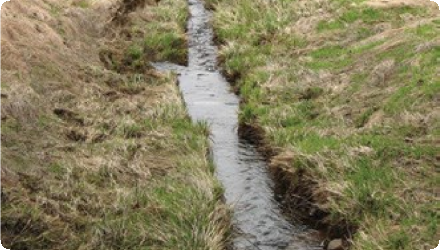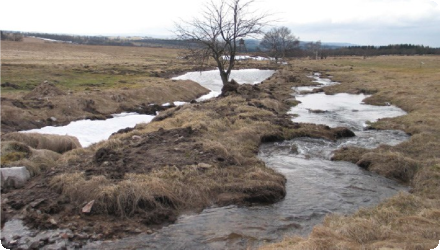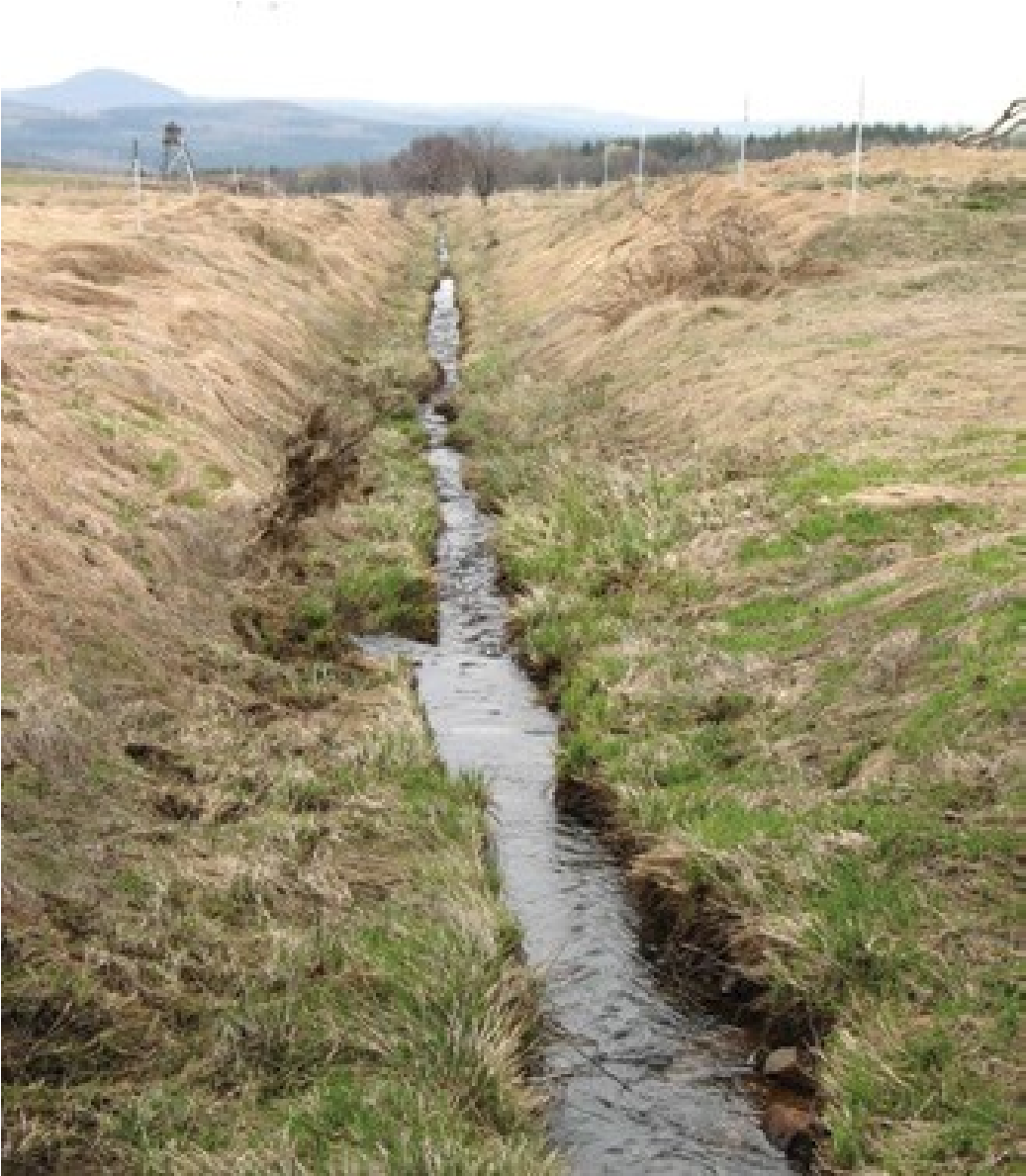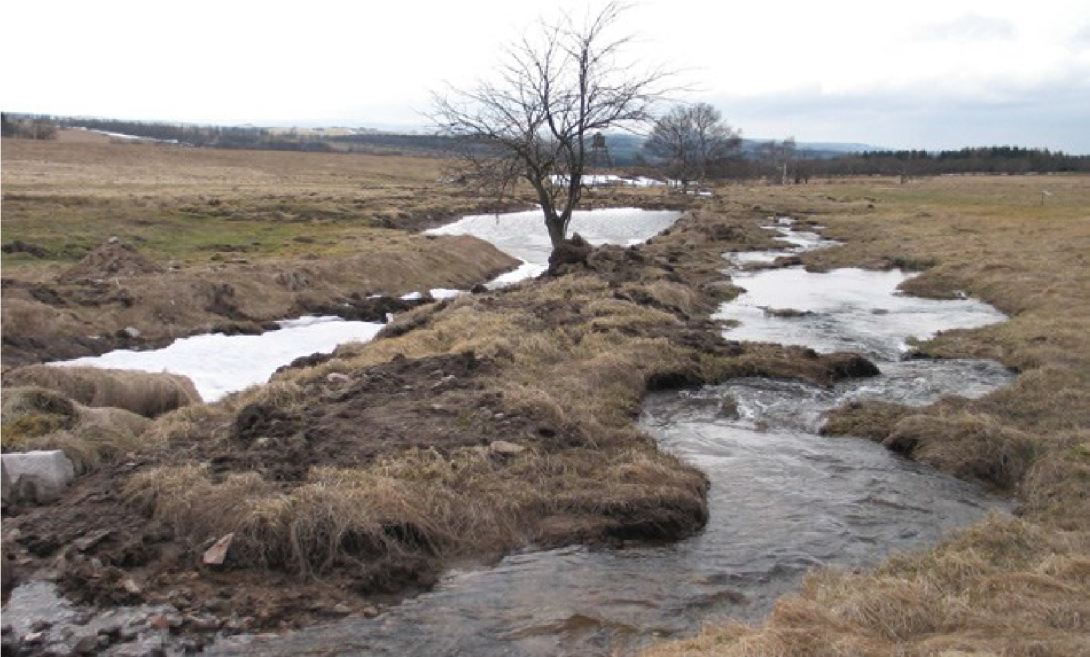Last update
2025
Summary
The Nature Conservation Agency of the Czech Republic (AOPK ČR) restored the Černý potok (Black Brook) in the Černá louka Nature Reserve (Ore Mountains, near Adolfov). Early trials began in 2001–2003; the main works in 2009–2010 (OP Environment/ERDF) went beyond in-channel fixes: shallow, meandering channels were newly excavated and reconnected to remnants of the historical course or led across alluvial meadows to reduce depth/volume, slow runoff and re-wet the peat meadows. Designed by Terén Design and built by EPS-Servis, the project reshaped ~2.5 km within the reserve and delivered c. 1,820 m of new channels, ~0.963 ha of ponds/wetland and an ~8 ha meander belt.
Post-restoration monitoring by UJEP found only very small lateral movement (≤10 cm), no significant incision, and that after 1980s straightening had shortened length by ~52% the restored reach in 2011 was ~43% longer than the straightened channel. AOPK notes continued monitoring and documented fish passage, incl. brown trout spawning. Media coverage during the 2019 drought reported the area stayed wet and ponds held water. In 2022, ČSOP with private partners extended restoration to a small tributary just outside the reserve.
Post-restoration monitoring by UJEP found only very small lateral movement (≤10 cm), no significant incision, and that after 1980s straightening had shortened length by ~52% the restored reach in 2011 was ~43% longer than the straightened channel. AOPK notes continued monitoring and documented fish passage, incl. brown trout spawning. Media coverage during the 2019 drought reported the area stayed wet and ponds held water. In 2022, ČSOP with private partners extended restoration to a small tributary just outside the reserve.
Position
Latitude
50.734
Longitude
13.8905
Project
NWRM
National Id
Czech_02
Installation date
2010
Implementation Status
Contact
Jovanka Ignjatovic, REC
RBD code
CZ_5000
Transboundary
0
Photo gallery
Location of the project
The Cerná louka (Eng. black Meadow) is a national Reserve (NR), within the Ramsar site Krusnohorska Mountains mires at northwest Czech Republic, along the border with Germany 50°44'4" N, 13°53'26" E, 690–760 m
NUTS Code
CZ04 - Severozápad
Project's objectives
Restore natural hydromorphology: reduce the depth/volume of the straightened channel; create new, shallow meandering channels and reconnect them to relic courses or route them across alluvial meadows.
Re-establish the water regime degraded by drainage and straightening: increase retention capacity and restore natural runoff conditions/retention space in PR Černá louka.
Support biodiversity associated with wetland habitats in the reserve (Natura 2000 mire meadows).
Re-establish the water regime degraded by drainage and straightening: increase retention capacity and restore natural runoff conditions/retention space in PR Černá louka.
Support biodiversity associated with wetland habitats in the reserve (Natura 2000 mire meadows).
Involved Partners
| Authority type | Authority name | Role | Comments |
|---|---|---|---|
Climate zone
cool temperate dry
Temperature
10
Precipitation
850
Annual rainfall range
600 - 900 mm
Runoff
0,024
Runoff coefficient
0,25
Runoff coefficient range
0.2 - 0.3
Runoff range
150 - 300 mm
Elevation range
713 m
Slope range
2-5%
Vegetation class
Grassland
Water bodies: Ecological Status
Poor
Water bodies: Chemical Status
Failing to achieve good
Water quality status
Cu < 0.02 mg/l Zn < 0.005 mg/l max T = 9 °C
Project scale
Meso
Project scale specification
Cerný potok watershed (the main stream and its tributaries). In total 43,000m2 of restored marches with still or running waters
Performance timescale
1 - 4 years
Project area
7,4
Area specifications
Both new and restored marshes with still or running waters 43,000 m2
Area subject to Land use change or Management/Practice change (ha)
7,4
Size
4
Size unit
km
Lifespan
50
The project was based on common principles of stream restoration. The main aim of the restoration was to decrease the volume of the restored streambeds especially by reducing their depth. Other important criteria included re-establishment of a natural gradient, near-natural proportions of the stream cross-section, and natural variety in current and calm ri9es
Modifications within the channelized streambed were not sufficient to respect all these criteria, therefore new streambeds were proposed and constructed. They were reconnected with the remains of the original stream course or directed freely to the alluvial meadows.
The volume of the new beds was designed at 30-day design flows (or max. one-year flows).
Modifications within the channelized streambed were not sufficient to respect all these criteria, therefore new streambeds were proposed and constructed. They were reconnected with the remains of the original stream course or directed freely to the alluvial meadows.
The volume of the new beds was designed at 30-day design flows (or max. one-year flows).
Natural overflow in case of Q100 foods (along meandering segment in the alluvium) 74000 m2
Design capacity description
- Restored stream sections (including adjustment of channelized streambeds and making water flow into the alluvium), 4,030 m
- Natural overflow in case of Q100 floods (along meandering segment in the alluvium) 74,000 m2
- Pools with marshes (restored or created marsh habitats), 9,630 m2
- Natural overflow in case of Q100 floods (along meandering segment in the alluvium) 74,000 m2
- Pools with marshes (restored or created marsh habitats), 9,630 m2
The area of interest is an important site for many rare and endangered plants (e.g. Menyanthes trifoliata, Pinguicula vulgaris) and animals (e.g. shore-birds, amphibians) of wetlands. It was necessary to take the conservation of these species into account during the restoration works.
The works would have to be conducted out of the nesting season of birds and metamorphosis of amphibians.
part of Natura 2000 network
Positive influence effectiveness
Presence of former wetlands and natural vegetation; Interest of local people and NGOs and their readiness to be involved and to contribute
Total cost
€316,000
Costs total information
2001†“2003: €52,000; 2008†“2010: €264,000
Costs investment
316000
Costs investment information
2001-2003: €52,000; 2008-2010: €264,000
Financing authorities
Compensations
0
Policy context
Comprehensive remediation of the hydrology of the area, initiation of natural, dynamic re-development of the stream channel and cessation of degradation processes in valuable habitats. These restoration measures are the main prerequisite for biodiversity protection including both stabilisation of local populations and spontaneous return of important wetland species, e.g. Snipe (Gallinago gallinago).
Also expected are flood control elements, e.g. reduction of the outflow velocity and retardation and flattening of flood waves.
Also expected are flood control elements, e.g. reduction of the outflow velocity and retardation and flattening of flood waves.
Land ownership
dozens of cadastral parcels belonging to multiple ownership
Community involvment
Yes
Design consultation activity
| Activity stage | Name | Key issues | Comments |
|---|---|---|---|
|
Design phase
|
NGOs were involved in the restoration project. Members of the Czech Union for Nature Conservation (Local Chapter Teplice †“ Fergunna) participated in study, project preparation and implementation.
|
||
|
Implementation phase
|
The restored site is used for education, and both experts and the public from the Czech Republic and abroad have visited it.
|
Policy target
| Target purpose |
|---|
|
Improved Biodiversity
|
|
Runoff control
|
|
Groundwater Recharge
|
Target Remarks
Biodiversity and gene-pool conservation in riparian areas
Regulation of hydrological cycle and water flow
Flood control and flood risk mitigation
Regulation of hydrological cycle and water flow
Flood control and flood risk mitigation
Policy pressure
| Pressure directive | Relevant pressure |
|---|---|
|
WFD identified pressure
|
4.1.5 Physical alteration of channel/bed/riparian area/shore – unknown
|
|
Floods Directive identified pressure
|
Other pressure contributing to flooding /flood risk
|
|
Other EU
|
Birds Directive 2009/147/EC Surface drainage and peat cutting
|
Policy impact
| Impact directive | Relevant impact |
|---|---|
|
WFD identified impact
|
Altered habitats due to hydrological changes
|
|
Floods Directive identified impact
|
Protected areas
|
|
Other EU
|
Loss of natural habitats and wild fauna and flora
|
Requirement directive
| Requirement directive | Specification |
|---|---|
|
WFD-mitigation of significant pressure
|
Restored stream sections (including adjustment of channelized streambeds and making water flow into the alluvium)
|
|
WFD-restoring a HMWB
|
Restored meandering segment and pools with marsh habitats
|
|
Floods Directive-mitigating Flood Risk
|
Natural overflow in case of Q100 floods
|
|
The Birds and Habitat Directives
|
Both new and restored marshes with still or running waters
|
Policy challenges requirements
National Wetlands Conservation Plan National Biodiversity Strategy
Contractual arrangements
0
| Arrangement type | Responsibility | Role | Name | Comments |
|---|
Part of wider plan
0
Wider plan type
| Wider plan type | Wider plan focus | Name | Comments |
|---|
Monitoring of the restored site was supported under the transboundary project “PestrýBunt”.
The effect of restoration on the local fauna and flora was monitored as well (Nature Conservation Agency of the Czech Republic, Czech Union for Nature Conservation, Local
Chapter Teplice – Fergunna, 2007–2011)
Biodiversity,flow velocity, kind and quantity of sediments and graphic cross section profiles
The effect of restoration on the local fauna and flora was monitored as well (Nature Conservation Agency of the Czech Republic, Czech Union for Nature Conservation, Local
Chapter Teplice – Fergunna, 2007–2011)
Biodiversity,flow velocity, kind and quantity of sediments and graphic cross section profiles
Maintenance
Maintenance activities will be focused on preservation of re-established natural conditions in the area, by the Local Chapter Teplice – Fergunna
Catchment outlet
The two dimensional hydrodynamic SRH-2D model
The efect of restoration on the flow rate and delays of the flood waves, as well as on local fauna and fora was monitored as well (Nature Conservation Agency of the Czech Republic, Czech Union for Nature Conservation, Local Chapter Teplice- Fergunna 2007-2011) but only preliminary results are available at present because of a relatively short post-restoration phase.
The effect of restoration on the flow rate and delays of the flood waves, as well as on local fauna and fora was monitored as well (Nature Conservation Agency of the Czech Republic, Czech Union for Nature Conservation, Local Chapter Teplice - Fergunna, 2007-2011) but only preliminary results are available at present because of a relatively short post-restoration phase.
Information on retained water
Dynamic meandering of the restored stream-bed is being studied, but long-term monitoring is necessary to obtain statistically significant results.
1,820 m new channels, 0.963 ha ponds/wetlands, ~8 ha meander belt; ~4.3 ha wetlands created/restored.
Post-works morphology (UJEP 2013): lateral shift ≤ 10 cm; no significant incision; after 1980s straightening (−52 % length), the restored reach was ~+43 % longer than the straightened one (measured in 2011).
The area stayed wet and ponds held water during the 2018–2019 drought.
1,820 m new channels, 0.963 ha ponds/wetlands, ~8 ha meander belt; ~4.3 ha wetlands created/restored.
Post-works morphology (UJEP 2013): lateral shift ≤ 10 cm; no significant incision; after 1980s straightening (−52 % length), the restored reach was ~+43 % longer than the straightened one (measured in 2011).
The area stayed wet and ponds held water during the 2018–2019 drought.
Information on increased water storage
In a model of a restored stream section of ca. 1 km in length, the delay was up to 2 hours for the 1-year flood compared to the regulated stream and a considerable 20 minutes for a 100-year flood.
Runoff reduction
45
Runoff reduction unit
% Percent
Information on runoff reduction
Very significant effect was recorded on the delay of the flood wave. As a consequence, the peak flow downstream can be reduced due to delayed peak flows from the tributaries
Peak flow rate reduction
5
Peak flow rate reduction unit
%
Information on Peak flow rate reduction
Only a small effect of the stream restoration on the peak flow was found with the exception of less frequent floods (N1, N2 and N5 peak flows were reduced by only 50-80 l/sec)
Information on Ecosystem water supply
It is not relevant for this application
Water quality overall improvements
Neutral impact-no change in WQ status
Information on Water quality overall improvements
Classified as good and very good condiions. pH = 6-8, high concentrations of dissolved oxygen.
Water quality Improvements Copper (Cu)
0,0199999995529652
Water quality Improvements (Cu) unit
mg/L
Water quality Improvements Zinc (Zn)
0,00499999988824129
Water quality Improvements (Zn) unit
mg/L
Water quality Improvements water temperature (W T°)
8
Water quality Improvements (W T°) unit
o C
Soil quality overall soil improvements
Not relevant for this application
Information on Soil quality overall soil improvements
It is not relevant for this application
1
The abundance of some amphibians has considerably increased in the constructed pools (e.g. hundreds of individuals of frog species, e.g. Bufo bufo, Rana temporaria, and dozens of individuals of Triturus vulgaris). A more frequent occurrence of some bird species of waterlogged meadows and marshes (such as Crex crex and Gallinago gallinago) was recorded mainly in the restored wetland habitats created by conducting small tributaries to the floodplain.
In 2011 about 20 dragonfly species were recorded. The local population of the endangered plant species Menyanthes trifoliata has increased in the floodplain.
Connectivity/biota: fish passage confirmed during brown trout spawning after restoration.
In 2011 about 20 dragonfly species were recorded. The local population of the endangered plant species Menyanthes trifoliata has increased in the floodplain.
Connectivity/biota: fish passage confirmed during brown trout spawning after restoration.
Ecosystem impact climate regulation
Not relevant for the specific application
Information on Ecosystem impact climate regulation
It is not relevant for this application
Ecosystem provisioning services
0
Information on Ecosystem provisioning services
It is not relevant for this application
Key lessons
Participatory approaches to wetland restoration design were critical for Project success, which hinged on changing people’s perceptions of wetlands, and gaining the full support for restoration among authorities and stakeholders. PA Local Consultative Councils and public awareness campaigns effectively supported stakeholder involvement.
Controlled restoration is a step in the right direction and is allowing further researches and studies concerning habitat restorations.
Solid knowledge on the baseline and the desired ecosystem status should be embedded early in project design phase.
“Let-nature-work” approaches (backfilling the entrenched channel and allowing free pathfinding) can reconnect the floodplain more fully than excavating a single new channel ; documented with rapid development of multi-thread flows and wetland formation.
Early post-restoration stability with minimal incision and measured lengthening supports using shallow, meandering designs on peat meadow streams.
Drought resilience is a tangible co-benefit worth monitoring and communicating (media-visible).
Pair public funding (OP Env/AOPK) with NGO/private finance to act on private land and speed delivery.
Controlled restoration is a step in the right direction and is allowing further researches and studies concerning habitat restorations.
Solid knowledge on the baseline and the desired ecosystem status should be embedded early in project design phase.
“Let-nature-work” approaches (backfilling the entrenched channel and allowing free pathfinding) can reconnect the floodplain more fully than excavating a single new channel ; documented with rapid development of multi-thread flows and wetland formation.
Early post-restoration stability with minimal incision and measured lengthening supports using shallow, meandering designs on peat meadow streams.
Drought resilience is a tangible co-benefit worth monitoring and communicating (media-visible).
Pair public funding (OP Env/AOPK) with NGO/private finance to act on private land and speed delivery.
Success factor(s)
| Success factor type | Success factor role | Comments | Order |
|---|---|---|---|
|
Specific incentives for stakeholder involvement
|
main factor
|
<p>New methods were applied in the design of shape and course of the streambed, and their successful implementation was enabled by good collaboration between investor, designer and subcontractors.</p>
|
1
|
|
Financing possibilities
|
main factor
|
Available financing for capital investments |
|
|
Attitude of decision makers
|
main factor
|
Commitment and support provided by competent authorities |
|
|
Attitude of relevant stakeholders
|
secondary factor
|
Local communities and NGO involvement and support. |
|
|
Public participation
|
secondary factor
|
The restored site is used for education, and both experts and the public from the Czech Republic and abroad have visited it |
Driver
| Driver type | Driver role | Comments | Order |
|---|---|---|---|
|
Past flooding events
|
main driver
|
Restoration of streams and their floodplains
|
1
|
|
Balancing different objectives
|
secondary driver
|
Restoration of other wetlands in the landscape
|
2
|
Flexibility adaptability
Adaptation to changing hydrological and habitat conditions have been achieved by a width range of structures reflecting surface, soil and geological conditions that are flexible concerning operation and further
improvement of hydraulic conditions
improvement of hydraulic conditions
Transferability
Similar restoration works could be designed for other (former) wetlands along medium rivers in their low-land segments.
Basin characteristics influence
The low inclination and the plain landscape allow the achievement of relatively large flooded areas, efficient restoration of meanders and habitats reconvention with no heavy structures.
Source(s)
English



